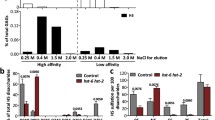Abstract
Glycosaminoglycans are important constituents of the extracellular matrix of vertebrates, where distinct changes in their distribution pattern occur during aging. However, little is known about their changes in the nematode Caenorhabditis elegans, which ages extremely rapidly compared to mammals.
The presence of glycosaminoglycans was analysed in cross-sections of all organs of the nematode, in three different age groups (60, 144, 228 h), using the electron-dense dye Cuprolinic Blue in conjunction with the critical electrolyte concentration method and specific glycosaminoglycan degrading enzymes. The nematodes (strain DH 26) were grown at 25.5°C.
The results indicate the presence of an organ-specific distribution pattern.
Chondroitin-4-sulphate and/or chondroitin-6-sulphate are present in the epicuticula. Chondroitin-4-sulphate and/or chondroitin-6-sulphate and dermatan sulphate are detected in the mesocuticula. If stained by conventional methods the mesocuticula shows an empty fissure, which is filled by chondroitin sulphates and dermatan sulphate as shown by Cuprolinic Blue staining and enzymes. Heparan sulphate is found in the terminal web of intestinal cells while dermatan sulphate is revealed in the central cores of microvilli. An unknown polyanion staining at high electrolyte concentrations is observed in the gonads. Age-related changes do not impair the composition of the glycosaminoglycan fraction.
In conclusion an unexpected highly differentiated pattern of glycosaminoglycans with high stability during aging exists.
Similar content being viewed by others
References cited
Brenner S (1974) The genetics of Caenorhabditis elegans. Genetics 77: 71.
Carey DJ, Todd MS (1986) A cytoskeleton-associated plasma membrane heparan sulfate proteoglycan in Schwann cells. J BiolChem 261: 7518-7525.
Cassaro CM, Dietrich CP (1977) Distribution of sulfated mucopolysaccharides in invertebrates. J Biol Chem 252: 2254-2261.
Certa HU (1979) Biochemische Charakterisierung definierter Entwicklungsstadien des Nematoden Caenorhabditis elegans. Diplomarbeit Göttingen.
Forssmann WG, Ito S, Aeki A, Dym M, Fawcett D (1977) An improved perfusion fixation method for the testis. Anat Rec 188: 307-314.
Ghandi S, Santelli J, Mitchell DH, Stiles JW, Sanadi DR (1980) A simple method for maintaining large, aging populations of Caenorhabditis elegans. Mech Ageing Dev 12: 137-150.
Greenwald I (1985) Lin-12, a nematode homeotic gene, is homologous to a set of mammalian proteins that includes epidermal growth factor. Cell 43: 583-590.
Hack V (1989) Ribonucleinpartikel und der Alterungsprozeß des Nematoden Caenorhabditis elegans. Diplomarbeit, Heidelberg.
Himmelhoch S, Zuckermann BM (1978) Caenorhabditis briggsae: Aging and the structural turnover of the outer cuticle surface and the intestine. Exp Parasitol 45: 208-214.
Himmelhoch S, Zuckermann BM (1983) Caenorhabditis elegans: Characters of negative charged groups on the cuticle and intestine. Exp Parasitol 55: 299-305.
Kjellén L, Lindahl U (1991) Proteoglycans: Structures and interactions. Annu Rev Biochem 60: 443-475.
Klass MR (1977) Aging in the nematode Caenorhabditis elegans: Major biological and environmental factors influencing life span. Mech Ageing Dev 6: 413-429.
Luft JH (1961) Improvements in epoxy resin embedding methods. J Biophys Biochem Cytol 9: 409-414.
Peixoto CA, Souza WD (1992) Cytochemical characterization of the cuticle of Caenorhabditis elegans. J Submicr Cytol Pathol 24: 425-435.
Poole AR (1986) Proteoglycans in health and disease: structures and functions. Biochem J 236: 1-14.
Robertson NP, Cain GD (1984) Glycosaminoglycans of tegumental fractions of Hymenolepis diminuta. Mol Biochem Parasitol 12: 173-183.
Rogalski TM, Williams BD, Mullen GP, Moerman DG (1993) Products of the unc-52 gene in Caenorhabditis elegans are homologous to the core protein of the mammalian basement membrane heparan sulfate proteoglycan. Genes Dev 7: 1471-1484.
Saito H, Yamagata T, Suzuki S (1968) Enzymatic methods for the determination of small quantities of isomeric chondroitin sulfates. J Biol Chem 243: 1536-1542.
Sames K (1990) Age-related changes of morphological parameters in hyaline cartilage. In: Robert L, Hofecker G, eds. The Theoretical Basis of Aging Research. Wien, Facultas Universitätsverlag, pp. 177-184.
Sames K (1994) The Role of Proteoglycans and Glycosaminoglycans in Aging. Basel, Karger.
Scott JE (1972) Differential staining of acid glycosaminoglycans (mucopolysaccharides) by Alcian-Blue in salt solutions. Histochemie 51: 722-726.
Scott JE (1980) The molecular biology of histochemical staining by cationic phthalocyanin dyes: the design of replacements for Alcian Blue. J Microsc 1l9: 373-381.
Scott JE (1985) Proteoglycan histochemistry — A valuable tool for connective tissue chemists. Collagen Rel Res 5: 541-575.
Scott JE, Dorling J (1965) Differential staining of acid glycosaminoglycans (mucopolysaccharides) by Alcian blue in salt solutions. Histochemie 5: 221-233.
Scott JE, Orford CR (1981) Dermatan sulphate-rich proteoglycan associates with rat tail-tendon collagen at the d-band in the gap-region. Biochem J 197: 123-216.
Sinohara H (1972) Molecular evolution of glycoproteins. Tohoku J Exp Med 106: 93-107.
Wood WB (1988) Introduction to Caenorhabditis elegans biology. In: Wood WB, ed. The Nematode Caenorhabditis elegans. New York: Cold Spring Harbor, pp. 1-16.
Author information
Authors and Affiliations
Rights and permissions
About this article
Cite this article
Schimpf, J., Sames, K. & Zwilling, R. Proteoglycan Distribution Pattern During Aging in the Nematode Caenorhabditis elegans: An Ultrastructural Histochemical Study. Histochem J 31, 285–292 (1999). https://doi.org/10.1023/A:1003761817109
Issue Date:
DOI: https://doi.org/10.1023/A:1003761817109




